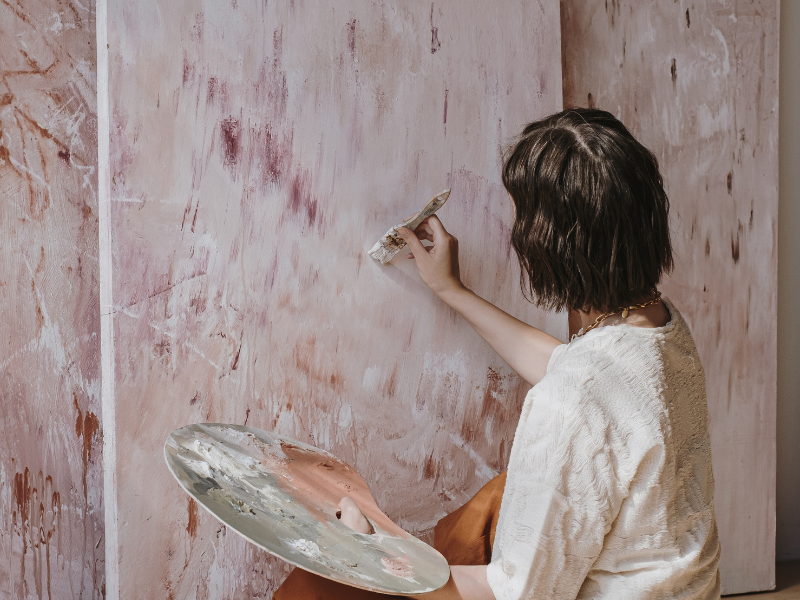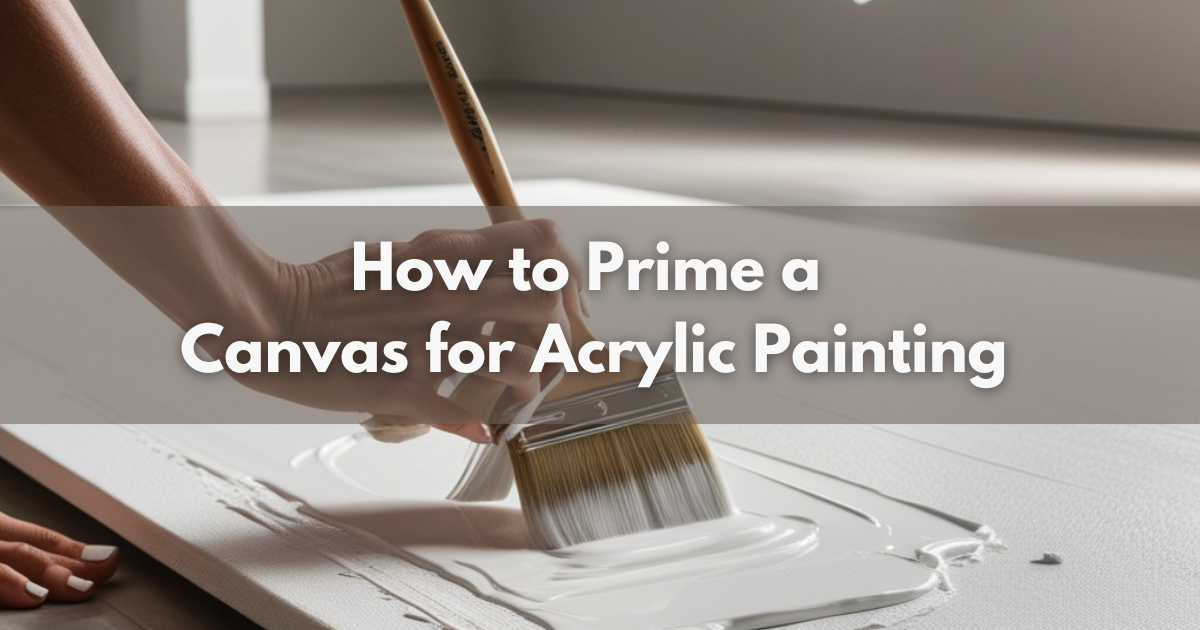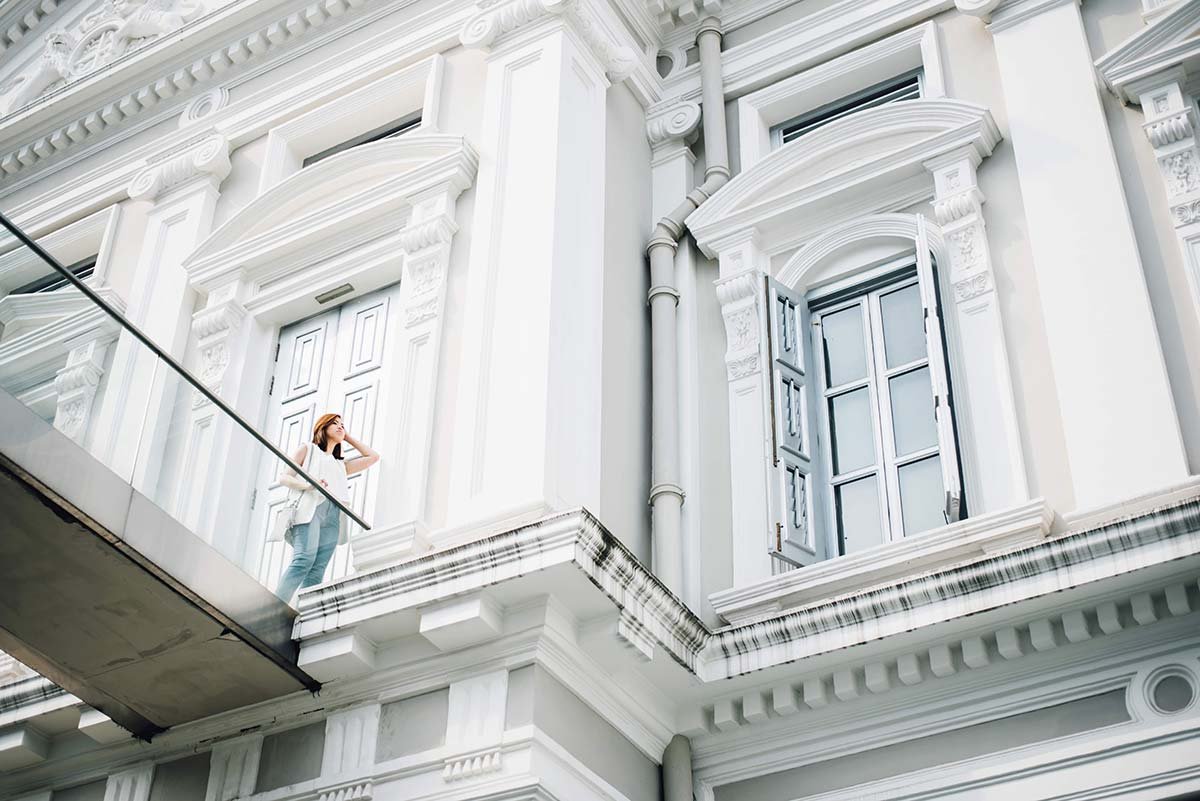Do you want to know how to prime a canvas for acrylic painting?
You are at the right place.
Priming a canvas is an essential step in preparing for acrylic painting. This process creates a smooth, even surface that helps your paint adhere better and last longer.
In this article, we’ll explore how to prime a canvas for acrylic painting, making it easy for beginners and experienced artists alike to achieve great results.
Understanding Canvas Types

Before we dive into the priming process, let’s take a look at the different types of canvases you might encounter:
Raw Canvas
Raw canvas is untreated and hasn’t been primed. It’s the most basic form of canvas and requires priming before use.
Pre-primed Canvas
Some canvases come pre-primed, which means they already have a layer of primer applied. However, many artists choose to add additional primer for better results.
Cotton vs. Linen Canvas
Cotton canvas is more common and affordable, while linen canvas is considered higher quality but more expensive. Both work well for acrylic painting when properly primed.
Materials Needed for Priming
To prime a canvas for acrylic painting, you’ll need:
1. Gesso (canvas primer)
2. Large, flat brush or foam roller
3. Sandpaper (220-grit)
4. Container for gesso
5. Drop cloth or newspaper
6. Scissors (if stretching your own canvas)
What is Gesso
Gesso is a key material when learning how to prime a canvas for acrylic painting.
It’s a white, paint-like substance that creates a smooth, even surface for your artwork.
Traditionally made from a mix of chalk, gypsum, and animal glue. But nowadays, gesso usually contains calcium carbonate, titanium dioxide, and an acrylic binder.
When you apply gesso to your canvas, it seals the fibers and creates a slightly textured surface that helps the paint hold better.
This is why using gesso is so important when you prime a canvas for acrylic painting. It also prevents the canvas from absorbing too much paint, which can lead to dull colors and an uneven finish.
Gesso comes in different forms – you can find it pre-mixed in jars or bottles or as a powder that you mix with water. While white is the most common color, you can also find black gesso or even tinted versions. Some artists even mix acrylic paint into white gesso to create custom-colored grounds for their paintings.
Remember, when using gesso to prime a canvas for acrylic painting, it’s best to apply multiple thin coats rather than one thick layer. This helps ensure an even, durable surface for your artwork.
You can learn more about Gesso, by reading this article: What is Gesso in this article you will get more in-depth knowledge about this art material.
Preparing Your Workspace

Before you start priming, it’s important to set up your workspace:
1. Choose a well-ventilated area
2. Cover your work surface with a drop cloth or newspaper
3. Gather all your materials
4. Put on old clothes or an apron to protect your clothing
Steps to Prime a Canvas for Acrylic Painting
Now that we’re ready, let’s go through the process of how to prime a canvas for acrylic painting:
Step 1: Inspect and Clean the Canvas
First, check your canvas for any dirt or debris. If you find any, gently brush it off with a clean, dry cloth.
Step 2: Stretch the Canvas (if necessary)
If you’re using an unstretched canvas, you’ll need to stretch it over a wooden frame. This step requires some practice, so don’t worry if it takes a few tries to get it right.
Step 3: Apply the First Coat of Gesso
Now, it’s time to apply the first coat of gesso. This is where we really start to prime the canvas for acrylic painting. Pour some gesso into a container and dip your brush or roller into it. Start in one corner and work your way across the canvas, applying a thin, even layer. Make sure to cover the entire surface, including the edges.
Step 4: Let It Dry and Sand
After applying the first coat, let it dry completely. This usually takes about 1-2 hours. Once dry, lightly sand the surface with 220-grit sandpaper. This helps create a smoother surface for the next coat.
Step 5: Apply Additional Coats
For the best results, apply at least two more coats of gesso, sanding between each coat. This ensures a smooth, even surface for your acrylic paint.
Step 6: Final Sanding and Finishing Touches
After your final coat has dried, give the canvas one last light sanding. Wipe away any dust with a clean, dry cloth, and your canvas is now primed and ready for painting.
Different Priming Techniques
While the basic process of how to prime a canvas for acrylic painting remains the same, there are a few variations you can try:
1. Tinted gesso: Mix a small amount of acrylic paint into your gesso for a colored base.
2. Textured priming: Use a texture medium or apply gesso with a palette knife for a more tactile surface.
3. Absorbent ground: Apply a specialized absorbent ground for a more matte finish.
Tips for Successful Priming
To ensure the best results when you prime a canvas for acrylic painting, keep these tips in mind:
1. Apply thin, even coats rather than one thick coat
2. Allow each coat to dry completely before sanding or applying the next coat
3. Sand gently to avoid damaging the canvas
4. Experiment with different priming techniques to find what works best for your style
Alternatives to Gesso
While gesso is the most common primer, there are alternatives:
1. Acrylic medium: Some artists use clear acrylic medium as a primer
2. DIY gesso: You can make your own gesso with white paint, chalk, and water
3. Specialty primers: There are primers designed for specific effects or techniques
Priming for Different Painting Styles
How you prime your canvas can affect your painting style:
1. Smooth surface: Multiple coats of gesso, well-sanded, create a smooth surface ideal for detailed work
2. Textured surface: Less sanding or intentionally applied texture works well for impasto techniques
3. Absorbent surface: Specialized absorbent grounds can create a more matte finish, similar to watercolor paper
Underpainting vs Priming
You will often hear about underpainting. It is quite natural to become confused about underpainting and priming.
Don’t worry.
We will clear you these two terms.
What is underpainting? What is the difference between underpainting and priming?
Underpainting and priming are two different steps in the painting process, though both happen before you start your main artwork.
Let’s break it down in simple terms.

When you prime a canvas for acrylic painting, you’re preparing the surface to receive paint. Priming usually involves applying gesso to create a smooth, even base. It’s like putting on primer before painting a wall in your house.
Underpainting, on the other hand, is the first layer of paint you apply to your primed canvas. It’s a basic version of your painting that helps set the tone and structure for your final piece. Think of it as a rough sketch, but with paint instead of pencil.
Here are the main differences:
- Timing: Priming comes before underpainting
- Purpose: Priming prepares the surface, underpainting starts the artwork
- Material: Priming usually uses gesso but underpainting uses paint
- Coverage: Priming covers the whole canvas evenly, but underpainting may be partial
So, while both are important steps in creating a painting, they serve different purposes in your artistic process.
Remember, you always prime before you underpaint.
Troubleshooting Common Priming Issues

Sometimes, you might encounter problems when priming your canvas. Here are some common issues and how to fix them:
1. Bubbles in gesso: Use a foam roller or brush out any bubbles as you apply the gesso
2. Uneven coverage: Apply thin, even coats and use long, smooth strokes
3. Cracking primer: This usually happens if the gesso is applied too thickly. Stick to thin coats and allow proper drying time
Maintaining Primed Canvases

To keep your primed canvases in good condition:
1. Store them in a cool, dry place
2. Keep them away from direct sunlight
3. If you need to touch up the primer, lightly sand the area and apply a thin coat of gesso
Environmental Considerations
When priming your canvas, consider these eco-friendly options:
1. Look for low-VOC or non-toxic primers
2. Dispose of materials properly
3. Consider using natural fiber brushes
Priming Canvases for Professional Results
To achieve gallery-worthy results:
1. Use high-quality materials
2. Take your time with each step
3. Consider using archival-quality primers for long-lasting artwork

Learning how to prime a canvas for acrylic painting is an important skill for any artist. With practice, you’ll find the method that works best for you.
Keep in mind, the key is to create a smooth, even surface that will make your acrylic paints look their best.
So grab your supplies, set up your workspace, and start priming.
Additional Resources
For more information on how to prime a canvas for acrylic painting, check out these resources:
1. “The Acrylic Painter’s Guide to Canvas Preparation” by Golden Artist Colors Click Here
2. “Painting in Acrylics: The Indispensable Guide” by Lorena Kloosterboer (available on Amazon)

Remember, the process of how to prime a canvas for acrylic painting might seem challenging at first, but with practice, you will get used to it, and it will be part of your parting process naturally.
Happy painting.







